- About us
- Support the Gallery
- Venue hire
- Publications
- Research library
- Organisation chart
- Employment
- Contact us
- Make a booking
- Onsite programs
- Online programs
- School visit information
- Learning resources
- Little Darlings
- Professional learning
Penny Sackett (b. 1956), physicist, astronomer and former Chief Scientist for Australia, gained her PhD in theoretical physics at the University of Pittsburgh. In 2002 she was appointed director of the Research School of Astronomy and Astrophysics at the Australian National University. Responsible for the Mount Stromlo Observatory, she had to endure its destruction by bushfires in January 2003, and negotiations for the insurance payout and rebuilding of the heritage-listed facility. Sackett was one of an international team of 73 astronomers who discovered the first known earth-sized planet orbiting a normal star other than the Sun in the inner Milky Way in 2006. Appointed the Chief Scientist for Australia in late 2008, Sackett remained an adjunct professor at ANU and continued to supervise research students. She resigned as Chief Scientist in 2011, announcing that she intended to contribute to science in other ways.
Entering this portrait in the Archibald Prize for 2011, Andrew Mezei said that he aspired to paint Sackett after hearing her speak on the radio. He wrote: 'She responded to scepticism about climate change with eloquent reasoning … I wanted to show her femininity as perfectly compatible with her impeccable focus on facts.' The setting is imagined, though informed by various images of Mount Stromlo Observatory.
Purchased 2012
© Andrew Mezei
Professor Penny Sackett, Astronomer and Physicist, by Andrew Mezei, 2011.
This work is an oil painting on linen set in a simple dark brown wooden frame standing 114 cm tall and 84 cm wide. The painting is in a true-to-life realistic style with dramatic lighting from the right creating dark shadows on the left sides of everything in the frame.
Professor Penny Sackett is shown seated in the centre of the frame in a slightly dilapidated observatory. In the foreground to her left, a very large blue and silver telescope on a square concrete plinth towers over her, taking up almost half of the frame, continuing beyond it to the left and partially obscuring Sackett’s right arm. Above the wide blue steel base, blue struts support the thick silver barrel of the telescope which is pointed upwards towards the left top corner and extends out of frame. At the low end of the barrel, the eye piece of the telescope – a silver metal cylinder with 3 smaller eyepieces – is partially obscured by the blue support strut. At the front of the concrete base, cast in shadow, the initials of the artist, AM, are carved into the concrete with the A above the M forming the shape of a compass.
Behind the telescope, Professor Sackett sits on a timber curved-framed chair in the centre of the frame, pointed diagonally to the right. She has a plush scarlet-red wool blanket over her knees which pools in folds on the ground and the toe of one dark leather shoe peeps out from beneath it. She holds a large blue and green globe of the Earth in her lap, with her left hand below supporting it from below and her right hand resting on top, gripping a yellow and black screwdriver as if it were a pencil.
She wears a dark-brown blazer over an open collared white shirt, her shoulders hunched slightly as she leans into the globe. Her gaze is directed upward and to the right, her face well-lit from an unseen source, while the back of her head and left side of her face are cast in shadow. She has fair grey hair pulled simply back with a clip and a soft wispy fringe brushed over her forehead. Arched eyebrows are raised above her dark eyes which convey a calm but alert expression of intent engagement, with fine lines at their outer corners. Her thin lips are slightly parted at the centre and there is a hint of a smile.
The floor of the room is made from diagonal chequered yellow and brown tiles which appear aged and chipped. Directly behind Sackett, a scuffed white wall is interrupted by a doorway through which a winding shadowy corridor is visible with a blue and white tiled floor. Above the wall, a metal railing of an unlit mezzanine level is partially obscured behind the large telescope and descends with a concrete staircase in darkness in the top left corner of the frame. The room’s lighting casts the railing’s shadow onto the arching wall behind it.
To the right of the doorway, a small round convex mirror is mounted on the wall. The mirror contains a reflection of the room in miniature which includes a view of Professor Sackett from behind and 2 other figures which are otherwise out of view in the frame. In the centre of the mirror, the artist is shown at an easel. To his right, another figure dressed in black faces Sackett, its finger pointed. This figure is the object of Sackett’s gaze. The shadow of this figure and its pointed finger is cast on the floor in the bottom right of the frame.
Below the mirror, a large metal silvery-blue machine sits on the floor against the wall with silver circular components protruding from its left side. Atop the machine, a short rod-shaped object leans against the back wall casting a shadow that with the object resembles an arrow or compass point.
Audio description written by Sally Dawson and voiced by Amy Middleby



On one level The Companion talks about the most famous and frontline Australians, but on another it tells us about ourselves.
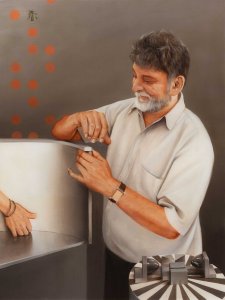
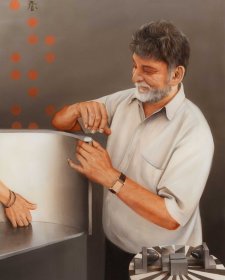
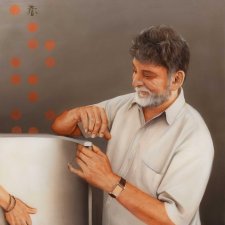
1 July 2015
Eminent doctors and scientists have for more than a century consistently caused our nation to punch far above her weight.
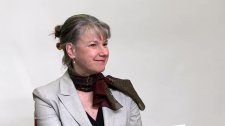
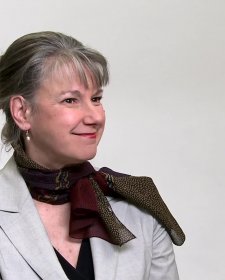
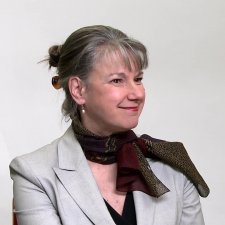
Professor Penny Sackett, Australian National University and former Chief Scientist for Australia (2008-2011) talks about her life in science.